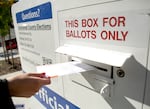Oregon voters are taking their time in marking primary election ballots before returning them for free via the U.S. Postal Service or at official drop boxes.
At least, that’s what the data released by the Oregon elections division on Wednesday suggests, with just 2.4% of ballots returned statewide. That’s on pace with Oregon’s number from the 2018 primary election, in which 2.5% of ballots had been returned by this same point.

A voter drops off a ballot at the Multnomah County election office in Portland, Ore., on November 2, 2020.
Kristyna Wentz-Graff / OPB
Of the nearly three million ballots sent to registered voters over the last week and a half, just over 70,000 have been returned.
Voters have until Tuesday, May 17, to either mail or physically return their ballot.
“What we are seeing is in line with previous primary elections,” said Secretary of State Shemia Fagan, who oversees all elections in Oregon.
“Voter turnout is generally high in Oregon thanks to our modern and convenient vote by mail system,” she said. “Oregonians are voters.”
Data compiled by the Bipartisan Policy Center — a Washington, D.C.-based nonprofit research group — shows that Oregonians do turn out well above the national average in both midterm and presidential elections. (Midterm elections take place two years between presidential elections and are typically dominated by congressional races for the U.S. House of Representatives and Senate, as well as state offices such as governor.)
In the 2018 primary election, 27% of all Oregonians 18 years of age or older returned a ballot, while the country averaged just 19%. Both those numbers were up from the 2014 primary.
Oregon’s historical turnout in midterm primaries improves when looking at only registered voters. In 2018, 34% of those who received a ballot returned them, a slight drop from 36% in 2014.
Elections officials and pollsters both say it’s hard to gauge what turnout will truly look like once the election is complete — Oregonians have only begun to see the expected flood of TV ads and mailers — but trust the state’s electorate to be fairly predictable in this primary at around 34% turnout.
Voters in Multnomah County are among the most active in the state with a turnout rate of 4.3% so far, with 22,809 ballots collected. When looking at Multnomah County’s numbers, county elections director Tim Scott said he agrees with state elections officials’ calculations that early turnout is at typical levels.
“We’re in the ballpark, anyway,” Scott said. “Four years ago, in 2018, we were at about 5% on the same day.”
Scott said the minuscule lag in early turnout could be attributed to the sheer number of candidates in some races such as the Republican primary for governor which features nearly 20 candidates.
“They have quite a bit of time left,” Scott said, “so people can take that time and make a thoughtful decision.”
He said his office has received a lot of calls with questions about individual voter registration and Oregon’s closed primary system – in which voters who aren’t affiliated with a party do not vote in party primaries. He’s heard fewer questions about the new look of Multnomah County’s ballots.
Some smaller counties are showing higher early turnout percentages — such as Wheeler County at 9.8% and Gilliam County at 7.4% — simply due to lower numbers of registered voters. For example, Wheeler County has 109 returned ballots but only 1,110 registered voters.
In the Portland metro region, Washington and Clackamas counties lag slightly behind at 1.7% (6,443 ballots) and 1.8% (5,567 ballots), respectively.
Daily vote count data from the 2018 primary compiled by Multnomah County shows turnout significantly picked up after the first week following ballots being mailed, jumping from a daily average of about 20,000 ballots returned the first week to 69,000 ballots in the week leading up to the election.
